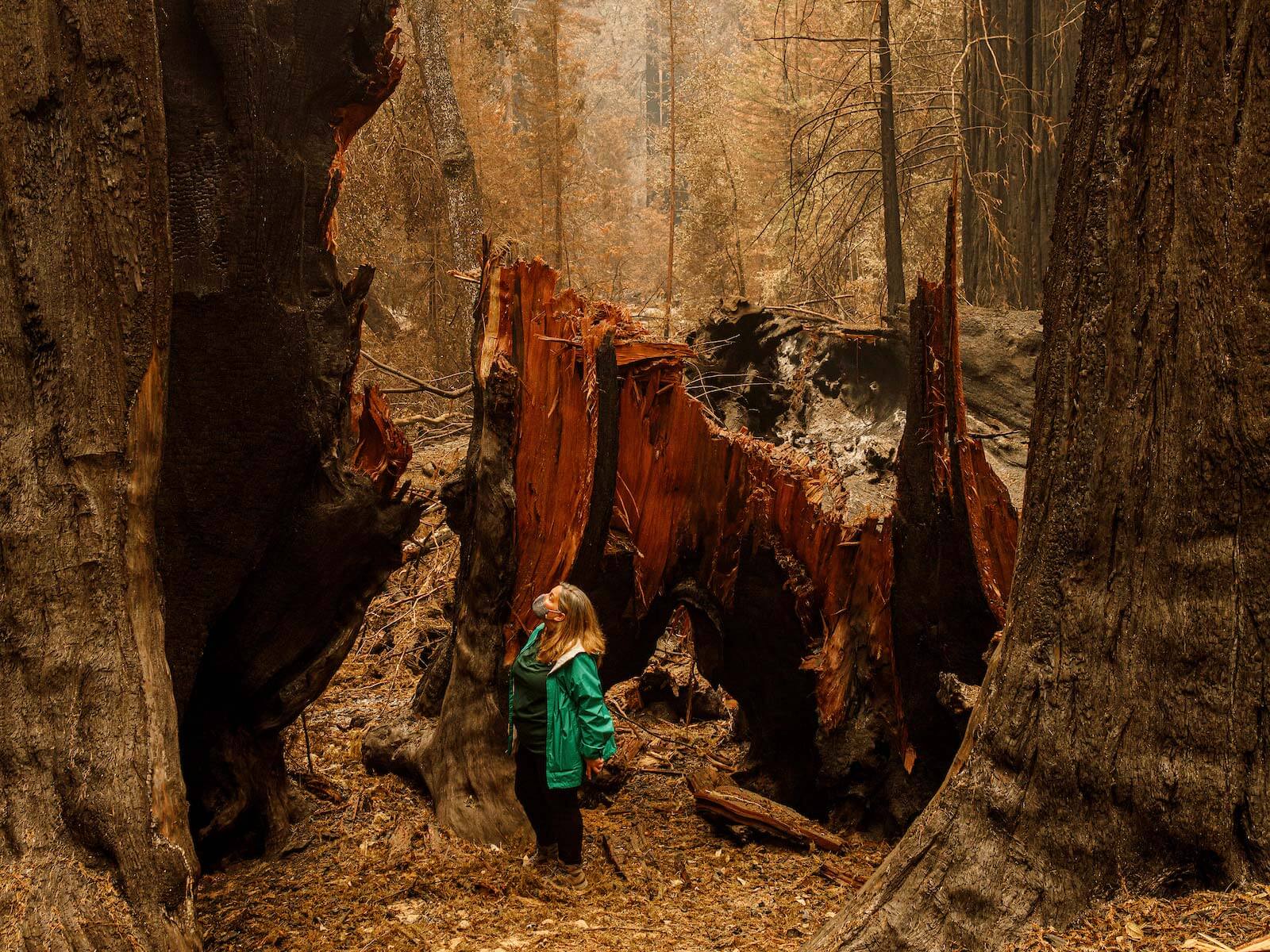What Recovery Means for Big Basin and Santa Cruz Redwoods

Evaluating Forest Health After a Fire
Although the fires are no longer consuming the landscape throughout the Santa Cruz Mountains, we still grieve for the people in our community whose lives were in danger during the CZU Lightning Complex wildfires in August and September 2020. Our top priority has been the safety of people—living and working in the fire’s path, staffing the parks, and in the firefighting and emergency response teams. We continue to ensure that teams have access to lands and roads to support wildfire recovery efforts.
At the same time, we continue to receive questions about what comes next. We don’t have all the answers, but we talked with Laura McLendon, our Director of Conservation, for a sense of what happened, and what’s to come, for redwood forests at Big Basin Redwoods State Park, and beyond.
Once the fires are out, what happens next? What are the first steps that we, or the state parks staff are going to take?
We own and manage a couple dozen redwood-forested properties in the Santa Cruz Mountains, totaling over 11,000 acres, including many adjacent to state parks impacted by wildfire, such as Big Basin. When the roads were safe from downed powerlines, hazard trees, and collapsed culverts and bridges, we began to assess the damage.
We began by assessing ecological damage and infrastructure impacts property-by-property. It is likely that we will face some serious landslide threats once the rainy season starts, so we have been proactive to do as much prevention and mitigation prior to the rainy season as possible. We are making progress although contractors are in enormous demand.
In 2021 we will be assessing and managing a huge influx of invasive species. Invasive species like French Broom and Yellow Star Thistle thrive post-fire. We are also replacing gates, locks, signs, wildlife cameras, and culverts. There will be huge impacts on streams due to increased debris and sediment from these fires and we will assess how to mitigate effects at each of our properties.
We will evaluate the need for reforestation or reseeding of native plants, but it is more likely that we will focus our efforts on clearing out debris and invasive species while allowing the forest to regrow on its own. Wildlife has already returned to most areas, but the return is slow, as food and shelter have diminished.
What does Big Basin recovery look like? What’s involved?
Similarly to the work on our properties, State Park staff will be clearing roads and trails, assessing ecological damage and safety threats, and replacing locks, gates, and signs. The much more challenging question for Big Basin will be to build the new infrastructure to support the public’s return to the park. The immediate recovery will be more about access and assessment. The longer-term recovery will take planning and more resources. You can read more about our expectations for Big Basin’s future here. You can also donate to the Big Basin’s Future Fund.
We launched an urgent Big Basin Recovery Fund, and were joined by Save the Redwoods League in that effort. What are the most urgent needs that our Fund will support?
Early in the fires we launched two funds to support redwoods restoration and recovery efforts at Big Basin. We were committed to helping California State Parks assess damage at Big Basin Redwoods State Park when it was safe enough to do so, knowing that recovery from that damage will require immediate resources, including equipment and personnel. Together with Save the Redwoods League we have raised more than $530,000 for Big Basin. In December, we began funding critical access and safety improvements. In April, 2021 we launched a Big Basin’s Future Fund.
What’s happened to the redwoods at Big Basin? What are the possible consequences? What does re-growth look like?
Fire is a natural part of the redwood forest ecosystem. We know that the 18,000 acres of forests throughout Big Basin have burned many times over the past millennia. We now know that the fire burned extremely hot in places and barely touched other places. We expect that most of the redwoods that weren’t felled during the storm will survive. We have seen regrowth already in the weeks and months following the fire. Two of the park’s iconic trees – the Mother and Father of the Forest trees – although scarred from fire, survived.
Redwoods in the Santa Cruz Mountains co-occur with two other main tree species: Douglas fir and tan oak. Both of these co-occurring species don’t survive fire as well as redwoods, so we have seen a lot of standing, dead Douglas fir and tan oak among the charred redwoods.
Redwoods are known for their re-growth in fire, even from burned-over crowns and tops. They can send out new growth from the burned top and create a new canopy structure over time. Within just a few weeks, we saw new redwood sprouts emerging in the worst-hit areas from the basal burl tissues around the base of each redwood. These tissues act as a seed bank, and fire releases the seeds to ensure regeneration. Weeks later some trees began “fuzzing out” from epicormic sprouting along the trunks. Read more here for ten signs of redwoods recovery after fire.
By next year, we should see a lot of new growth coming up on the forest floor and a return of wildlife en masse with this new growth. We remain optimistic that the forests of Big Basin and the surrounding area will thrive once again post-fire. It will just take time.
Redwoods thrive in fire. Are they different from other trees when it comes to fires?
Although many of the oldest trees in Big Basin burned in the CZU Lightning Complex fire, a majority of them will live through this catastrophe. Why? Because the redwoods have unique adaptations that make them extraordinarily resistant to fire. Their thick bark is quite fire-resistant – several feet thick in old-growth individuals – and contain almost no flammable pitch or resin.
Redwoods can sprout new growth from the base of the tree, can re-grow new tops when the canopy is damaged and can survive for centuries even when the entire interior of the tree – the heartwood – has been lost to fire. As long as the cambium layer survives in most of the tree, and the roots are still stabilized, the tree will likely recover very well after a major fire. Fallen trees become “nurse trees” that foster new growth. Read more about what makes redwoods so resilient.
When we talk about “old growth” trees, how old are we talking about?
Officially, the oldest living coast redwood is at least 2,200 years old, but foresters believe some coast redwoods may be much older. Most of the redwoods we see today are about 50-150 years old. That’s equivalent to about age 2-6 in human years.
Coast redwoods can grow 100 feet in their first 50 years, so they quickly look like grown-ups. When you walk or ride through the Santa Cruz Mountains, remember you are in a nursery of young redwoods that, if protected, can live for 2,000 years and can help rebuild a healthy redwood forest for people, wildlife, and future generations. Read more about what “old-growth” means and why it matters.
What’s happened to wildlife? What might have been lost? What might have survived?
Many animals are likely to have burrowed, flown away, or ran away. Source populations from surrounding parks and wildlands will likely return in high numbers in the spring once new growth returns.
Early reporting confirmed that wildlife was already returning to Big Basin. And reports from post-fire areas elsewhere in California have been very positive for wildlife: they do bounce back, they do survive. This isn’t their first wildfire and won’t be their last.
We are concerned about some important species that rely on coast redwoods to thrive. The marbled murrelet is a seabird, but loves the cool canopies of redwoods for its nesting. The murrelet is endangered, and efforts to account for their numbers, much less protect them, may have been significantly curtailed by these wildfires.
What’s happened to other forests in the region?
The August wildfires in the Santa Cruz Mountains burned more than 86,000 acres, including forests at well-known parks such as Big Basin, Butano, and Henry Cowell state parks. The damage and impacts will differ from park to park, and the heart of the fire was at Big Basin. But the fires, including spot fires, have hit other private forest lands, including San Vicente Redwoods, a forest partnership Sempervirens Fund manages with POST, Land Trust of Santa Cruz County, and Save the Redwoods League. That fire was also present in the adjacent Cotoni-Coast Dairies National Monument, inland from Davenport.
The effects on the bioregion as a whole won’t be evident for years and maybe decades to come, but redwoods are remarkably resistant and actually thrive in the aftermath of fire. The immediate impacts will be on the loss of other plant species, such as Douglas fir and tan oak, and on damage to root systems and loss of infrastructure, including important fire-fighting resources such as water tanks and water lines that have melted.
There will be a lot of infrastructure recovery to plan for and manage. We will learn from this fire how to improve our efforts to situate fuel breaks, water tanks, and other firefighting resources for future fires.
Is fire part of a healthy forest? Why are these fires any different?
Fire is a natural part of the redwood forest ecosystem. Many species and ecosystems in this region are well adapted to fire, some even require it to sprout. Fire also returns nutrients to the soil and can stimulate the growth of a wide array of species. We know that the forests of Big Basin have burned many times over the past millennia. What we don’t know about this fire is how hot it burned in certain places and therefore don’t yet know quite what to expect the future redwood forest composition and structure to look like.
The CZU Lightning Complex fires burned “dirty,” meaning it burned in some patches and not in others. Where the fire burnt hottest, we’re bound to see higher tree mortality across all species. Where the fire made it into the canopy, we will likely see greater tree mortality. Crown fires can spot and send embers way ahead of the fire front, which makes it particularly dangerous for evacuations and difficult to fight or control. But where the fire mostly burned in the understory, we will likely see most trees survive.
What can people do?
Certainly, the most important thing is to heed safety orders and stay away from closed parks. There’s going to be substantial recovery efforts across the region. The sooner crews can do that work unencumbered, the more quickly they can make progress.
If you want to help Big Basin recover or help restore redwood forests, consider a donation to Sempervirens Fund. We are continuing our work to protect and permanently preserve redwoods, and have begun landscape-scale restoration efforts across the region.
We are also closely involved in supporting Big Basin as it recovers, and as State Parks plans for the parks next act. We want you to have a voice in that process. We will keep our community up to date. Stay informed on our progress. Sign up for news here.


